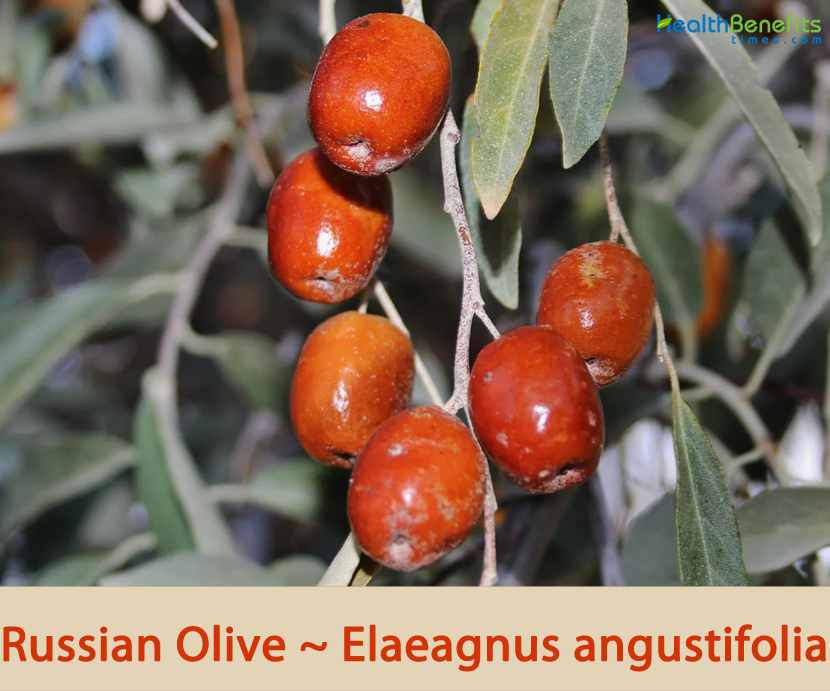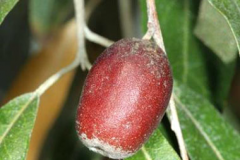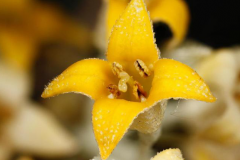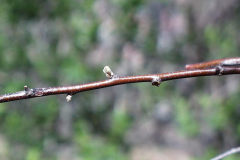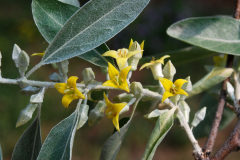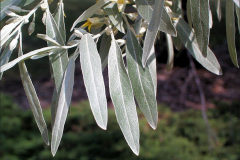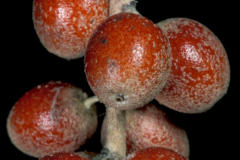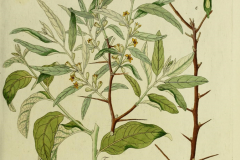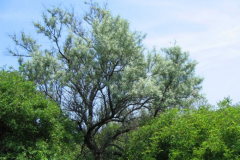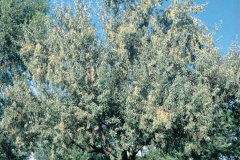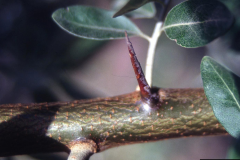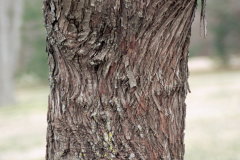The genus name Elaeagnus comes from the Greek words elaia which means “olive tree” and agnos meaning “chaste” or “pure”. Specific epithet means having narrow leaves. Russian olive fruits have high nutritional values and consist of proteins, sugar, vitamins and minerals. The flowers are small, fragrant, and a yellowish-white color and have been used as a source of nectars for honey bees, as well as a flavoring agent in liqueur production. The flowers have also been used to treat tetanus in traditional medicine. Fruit is edible, and is sometimes used for making preserves.
Different parts of the Russian olive plant have been used in a variety of medicinal formats, in perfume industries, as well as in wood-work and musical instruments production. Fruit is also attractive to wildlife. Although relatively tame in the St. Louis climate, Russian olive has aggressively naturalized in many parts of the West, particularly in water sheds and marshlands of the Great Plains where it has self-seeded and spread along rivers and wetland areas, crowding out native plants such as cottonwoods and willows, to the point where it is now being considered a noxious weed.
Russian Olive Facts
| Russian Olive Quick Facts | |
|---|---|
| Name: | Russian Olive |
| Scientific Name: | Elaeagnus angustifolia |
| Origin | Western and central Asia, Iran, from southern Russia and Kazakhstan to Turkey, parts of Pakistan and parts of India |
| Colors | White when first formed, yellow or light green when they are young, and brown or dark red when they are matured |
| Shapes | Clusters of fruit, a small cherry-like drupe 1–1.7 cm (3⁄8–5⁄8 in) long, orange-red covered in silvery scales. The fruits are about 1 cm wide and sweet, though with a dryish, mealy texture |
| Taste | Slightly sweet and pleasant to the taste |
| Health benefits | Support for indigestion, diarrhea in children, abdominal pain, excessive menstruation, cold limbs, insomnia, poor eyesight, menopause, coughing/burning in the lungs, headaches, memory loss, stomach pain, chronic enteritis, ulcers, festering wounds and boils. |
| Name | Russian Olive |
|---|---|
| Scientific Name | Elaeagnus angustifolia |
| Native | Western and central Asia, Iran, from southern Russia and Kazakhstan to Turkey, parts of Pakistan and parts of India. It was introduced to the United States in the early 1900s and became widely distributed due to its extensive use as an ornamental species in drier regions of the Great Plains and Rocky Mountains |
| Common Names | Russian-olive, elaeagnus, trebizond-date, silver berry, oleaster, wild olive, autumn olive; Bohemian olive; narrow-leaved oleaster; Russian silverberry; Russian-olive; silver berry; trebizond date, Russian Elaeagnus, Eastern Oleaster, Sweet Olive, wild olive |
| Name in Other Languages | Afrikaans: Russiese olywe Albanian: Ulliri rus, hunap Amharic: Yerusīya yeweyira (የሩሲያ የወይራ) Arabic: Zaytun rwsy (زيتون روسي), khilaf diq al’awraq (خلاف ضيق الأوراق) Armenian: Rrusakan dzit’aptugh (ռուսական ձիթապտուղ), P’shateni neghaterev (Փշատենի նեղատերև) Azerbaijani: Rus zeytun, Daryarpaq iydə Basque: Olibo zume, olibo-zumea Belarusian: Lokh vuzʹkolystyy (лох вузкалісты) Bengali: Rāśiẏāna jalapā I (রাশিয়ান জলপাই) Bulgarian: Ruska maslina (руска маслина), mirizliva vŭrba (миризлива върба), eleagnus (елеагнус) Burmese: Rusharr sanlwin (ရုရှားသံလွင်) Catalan: Arbre del paradís, arbre argentat, arbre de la plata, olivera del paradís Chinese: Èluósī gǎnlǎn (俄罗斯橄榄), sha zao (沙枣), xia ye mu ban xia, guixiangliu (桂香柳), jinlinghua, qilixiang (七里香), shazao, xiangliu (香柳), yinliu (银柳),Cì liǔ (刺柳), Gěi jié gé dài (给结格代), Hóngdòu (红豆), Yá gé dá (牙格达), Yín liǔ hú tuí zi (银柳胡颓子), Zé gěi máo dào (则给毛道), Shā zǎo huā (沙枣花), Shā zǎo jiāo (沙枣胶), Shā zǎo shù pí (沙枣树皮) Croatian: Ruska maslina, Dafina, uskolisna zlolesina, Czech: Ruská olive, Hlošina úzkolistá, česká oliva Danish: Russisk oliven, Smalbladet sølvblad Dutch: Russische olijf, Smalle olijfwilg, smalbladige olijfwilg, smalle olijfwilg English: Russian olive, Trebizond-date, Oleaster, Russian Elaeagnus, Elaeagnus, Eastern Oleaster, Sweet Olive, Russian silverberry, wild olive Esperanto: Rusa olivarbo Estonian: Vene oliiv, ahtalehine hõbepuu Filipino: Russian olive Finnish: Venäjän oliivi, Idänhopeapensas French: Olive russe, Chalef, Olivier de Bohême, arbre d’argent, olivier sauvage, arbre du paradis, chalef à feuilles étroites, olinet, éléagne à feuilles étroites Galician: Árbore do paraíso Georgian: Rusuli zetiskhili (რუსული ზეთისხილი) German: Russische Olive, Schmalblättrige Ölweide, Ölweide Greek: Rosikí eliá (ρωσική ελιά), Moschoitia, Tzitzifia, Zizyfia Gujarati: Raśiyana ōliva (રશિયન ઓલિવ) Hausa: Rasha Hebrew: Yitzharon machsif, זית רוסי, יצהרון מכסיף, יִצְהָרוֹן מַכְסִיף Hindi: Roosee jaitoon (रूसी जैतून) Hungarian: Orosz olajbogyó, Keskenylevelű ezüstfa Icelandic: Rússneskur ólífuolía Indonesian: Zaitun rusia Irish: Olóige Rúisis Italian: Oliva russa, eleagno, eleagno balsamico, olivastro, olivo di boemia, Olivagno Japanese: Roshian orību (ロシアンオリーブ), Yanagibagumi (ヤナギバグミ) Javanese: Zaitun rusia Kannada: Raṣyāda āliv (ರಷ್ಯಾದ ಆಲಿವ್) Kazakh: Orıs zäytüni (орыс зәйтүні), Üşkirjemis jïdesi (Үшкіржеміс жидесі) Korean: Leosia ollibeu (러시아 올리브) Kurdish: Zeytûnê Russian Ladakhi: Sarsing (སརསིང) Lao: Mak kok thed (ໝາກ ກອກເທດ) Latin: Russian oliva Latvian: Krievu olīvas, Šaurlapu eleagns Lithuanian: Rusų alyvuogių, Siauralapis žilakrūmis Macedonian: Ruski maslinovo (руски маслиново), dafina (дафина) Malagasy: Oliva rusia Malay: Zaitun rusia Malayalam: Raṣyan oliv (റഷ്യൻ ഒലിവ്) Maltese: Żebbuġa Russa Marathi: Raśiyana ŏlivha (रशियन ऑलिव्ह) Mongolian: Oros oliv (орос олив) Nepali: Rasiyana jaituna (रसियन जैतुन) Netherlands: Olijfwilg, smalbladige Norwegian: Russisk oliven, Smalsølvbusk, Smalbladet sølvbusk Oriya: ଷିୟ ଅଲିଭ୍ | Pashto: روسی زیتون Persian: زیتون روسی Polish: Rosyjska oliwka, Oliwnik wąskolistny, oliwnik zwyczajny Portuguese: Azeitona russa, Árvore-do-paraíso, oleastro, oliveira-da-boémia, oliveira-do-paraíso Punjabi: Rūsī jaitūna (ਰੂਸੀ ਜੈਤੂਨ) Romanian: Măslin rusesc, Sălcioară Russian: Russkaya olyva (русская олива), Olkh uzkolistnyy (Лох узколистный) Serbian: Ruska maslina (руска маслина), Dafina (Дафина) Sindhi: Rus zitun (رُوس زيتون) Sinhala: Rusiyānu oliv (රුසියානු ඔලිව්) Slovak: Hlošina úzkolistá, česká oliva Slovenian: Ruska oljka, ozkolistna oljčica Spanish: Aceituna rusa, Armuelle de fruto carnoso, Azufaifo blanco, Cinamomo, Metapolilla, Olivo de Bohemia, Panji, Panjino, Árbol del paraiso, Árbol del paraíso, eleagno, panjí Sundanese: Zaitun rusia Swedish: Ryska olivolja, Smalbladig silverbuske Tajik: Zajtunu rus (зайтуну рус) Tamil: Raṣya āliv (ரஷ்ய ஆலிவ்) Telugu: Raṣyan āliv (రష్యన్ ఆలివ్) Thai: Makxk rạs̄seīy (มะกอกรัสเซีย) Turkish: Rus zeytini, Kuş iğdesi, iğde Ukrainian: Rosiysʹka olyvkova (російська оливкова), Maslynka vuzʹkolysta (Маслинка вузьколиста) Upper Sorbian: Wuski dźiwi wolijowc Urdu: روسی زیتون Uzbek: Rus zaytun, Jiyda Vietnamese: O liu Nga Welsh: Olewydd russian Zulu: Isivini se-oliva |
| Plant Growth Habit | Large, thorny, perennial deciduous shrub or small tree |
| Growing Climates | Mountainous areas, plains, sands, desert, floodplains, river banks, stream courses, marshes, grasslands, roads, railways, fence lines, irrigation ditches, springs, riparian corridors, sub-irrigated pastures, saline affected areas, some wetland site |
| Soil | Thrives under a wide range of soil textures from sand to heavy clay, and can withstand flooding and silting. It grows best in deep sandy or loamy soils with only slight salt and alkali content |
| Plant Size | 5–7 meters (16–23 feet) tall and 100 cm in diameter |
| Root | Deep taproot and well-developed lateral root system |
| Bark | Smooth and gray when young, becoming irregularly ridged and furrowed later |
| Branch | Branches are flexible, pubescent (grey and scaly) and often have a short thorn at the end. |
| Twigs | Young branches are silvery and scaly, and may bear thorns. Later developing a shiny light brown color; buds are small, silvery-brown and rounded, covered with 4 scales |
| Leaf | Alternately arranged, toothless, and narrowly lanceolate to elliptic in shape and 4-8 cm (1.6-3.1 inches) long and 1.0-2.5 cm (0.39- 0.98 inches) broad, blunt or pointed at the tip, mostly wedge-shaped at the base. Leaves have smooth margins |
| Flowering season | May and June |
| Flower | Flowers are funnel-shaped, about ½ inch long and about as wide, with 4 spreading, triangular, petal-like sepals that are creamy-white to yellow on the inner surface and silvery on the outer, and fused at the base forming a squarish tube about as long as the sepal lobes |
| Fruit Shape & Size | Clusters of fruit, a small cherry-like drupe 1–1.7 cm (3⁄8–5⁄8 in) long, orange-red covered in silvery scales. The fruits are about 1 cm wide and sweet, though with a dryish, mealy texture |
| Fruit Color | Fruit are white when first formed, yellow or light green when they are young, and brown or dark red when they are matured. |
| Fruit Weight | From 0.32 to 3.04 g, with an average of 1.48 |
| Taste | Slightly sweet and pleasant to the taste |
| Plant Parts Used | Fruit, seeds, flowers, bark, leaves, roots, oil |
| Propagation | Primarily by seed, also vegetatively or by root sucker at the root crown |
| Lifespan | 80–100 years |
| Season | August to October |
| Health Benefits |
|
Plant Description
Russian olive is a long lived tree (80–100 years) that normally grows about 5–7 meters (16–23 feet) tall and 100 cm in diameter and starts to fruit after 5–6 years. It has spreading branches that form a dense and rounded crown. The plant is found growing in mountainous areas, plains, sands, desert, floodplains, river banks, stream courses, marshes, grasslands, roads, railways, fence lines, irrigation ditches, springs, riparian corridors, sub-irrigated pastures, saline affected areas and some wetland site. The plant can thrives under a wide range of soil textures from sand to heavy clay, and can withstand flooding and silting. It grows best in deep sandy or loamy soils with only slight salt and alkali content. It grows best in inland areas with warm summers and cold winters. It can establish in a broad range of conditions–from full sun to shade, where the water table is shallow or deep, and in flooded or rain-wetted sites. This tree can tolerate a wide range of harsh environmental conditions such as flood, severe drought, stony, sandy and high salinity or alkalinity of the soils.
Root
Elaeagnus angustifolia has a deep taproot and extensive root system with many well developed lateral roots. It is an actinhorhizal species, able to participate in a nitrogen-fixing symbiosis with action-mycetes of the genus Frankia. It can propagate vegetatively by sprouting from buds formed where the stem meets the root (called the root crown) or directly from the roots.
Stem
New twigs are densely covered in silvery-white scales, becoming smooth and shiny reddish-brown moderately to densely covered in pale lenticels (pores) the second year.
Branches are sometimes thorny, the thorns up to 2 inches long, shiny dark reddish-brown. Older bark is gray, rough and somewhat flaky, peeling off in narrow strips. A mature tree is up to 6 inches in diameter at breast height, the crown is heavily branched, rounded, and about as broad as tall. Plants can spread from root suckers.
Leaves
Leaves are alternately arranged, toothless, and narrowly lanceolate to elliptic in shape and 4-8 cm (1.6-3.1 inches) long and 1.0-2.5 cm (0.39- 0.98 inches) broad, blunt or pointed at the tip, mostly wedge-shaped at the base. Leaves have smooth margins. New leaves are densely covered in silvery-white scales on both surfaces; the upper leaf surface is gray-green and moderately covered with silvery star-shaped hairs and scales, giving the leaf a faded appearance. The lower surface of the leaf has a light grey color and is densely coated with silvery peltate scales. As is typical of nitrogen-fixing plants, Elaeagnus angustifolia leave have high nitrogen content.
| Leaf arrangement | Alternate |
| Leaf type | Simple |
| Leaf margin | Entire |
| Leaf shape | Oblong, lanceolate |
| Leaf venation | Pinnate |
| Leaf type and persistence | Deciduous |
| Leaf blade length | Less than 2 inches, 2 to 4 inches |
| Leaf color | Silver |
| Fall color | No color change |
| Fall characteristic | Not showy |
Flower
1 to 3 short-stalked flowers occur in the leaf axils of the current year’s new branches. Flowers are funnel-shaped, about ½ inch long and about as wide, with 4 spreading, triangular, petal-like sepals that are creamy-white to yellow on the inner surface and silvery on the outer, and fused at the base forming a squarish tube about as long as the sepal lobes. Inside the tube are 4 yellow stamens and a pale style. The stalk and outer surface of the sepals are densely covered in silvery scales. Flowers are very fragrant. Flowers bloom May to June and are pollinated by insects. The plants begin to flower and fruit from 3 years old.
| Flower color | White/cream/gray |
| Flower characteristics | Not showy |
Fruit
Fertile flowers are followed by followed by clusters of fruit, a small oval to nearly round cherry-like drupe 1.0-1.7 cm (3⁄8–5⁄8 in) long and 1 cm wide. Fruit is densely covered in silvery scales when young, becoming mostly smooth with maturity. The fruit are white when first formed, yellow or light green when they are young, and brown or dark red when they are matured. The fruits are sweet, though with a dryish, mealy texture. The pit inside is elliptic, nearly as long as the drupe. The fruit needs to be fully ripe (around September to October) if planning to ingest. The fruits can last throughout the winter.
Seeds are contained in yellow-brown berries are rather large and can be up to 0.4 in. (1 cm) long. Seeds are spread mainly by birds and remain viable in the soil for three years.
| Fruit shape | Round, oval |
| Fruit length | Less than .5 inch |
| Fruit covering | Fleshy |
| Fruit color | Yellow |
| Fruit characteristics | Attracts birds; not showy; fruit/leaves not a litter problem |
Health Benefits of the Russian Olives
Russian olive tree is rich in flavonoids, alkaloids, water, and fat-soluble vitamins, as well as carbohydrates and biologically active lipids. This is why Russian olive extracts have been frequently used in traditional herbal medicine. Let’s look at some of the health benefits of this hardy, deciduous tree.
1. Reduces inflammation
Recent research showed that Russian olive fruit extracts helped to considerably decrease pain and inflammation in women suffering from knee osteoarthritis.
2. Treats wounds
Russian olive fruit extracts have also been proven to accelerate wound healing and closure. The Vitamin A in the fruit extracts boost epidermis regeneration and reduces inflammation and pain.
3. Muscle relaxant
Numerous researches have reported on the muscle relaxant properties of Russian olive leaf and fruit extracts. These studies showed that the muscle relaxing effects of the aqueous and ethanol extracts were similar to diazepam in controlled doses.
4. Powerful antioxidant
Leaves and flowers of the Russian olive tree consist of flavonoid compounds, a powerful antioxidant element that has been shown to reduce oxidative stress as well as the risk of degenerative diseases.
Traditional remedies of Elaeagnus angustifolia
| Country | Extract | Application | Rout of administration |
|
Iran |
Infusion of the dried flowers | Anti-pyretic | Oral |
| Infusion of the dried leaves | Astringent | Oral | |
|
Turkey |
Fresh branch in hot water | To remove wart | External |
| Decoction of barks | Gall bladder problems and kidney stones | Drink one teacup twice a day for 20 days | |
| Extract of leaves with the ash of Salix sp. bark | To treat abscess | External | |
| Fruits | Kidney stones | Oral | |
| Tea or decoction of root barks | Dysuria | Oral | |
| Extract of leaves with Juglansregia and Menthalongifolia | Sun block | External | |
| Azerbaijan | Infusion of the aerobic parts | Treatment of alimentary canal | Oral |
Traditional uses and benefits of Russian olive
- The plant is famous for its medicinal application.
- Berry is useful in treating flu, fever, cough, diarrhea, joint pain, ulcer, gastric problem, kidney problems, etc.
- Leaves are considered a good source of vitamin and are used as tea leaves.
- It also acts as a pain killer.
- Roots of the plant are used to treat kidney problems.
- Leaves, shoots, flowers, fruits and bark have been traditionally used in Chinese medicine.
- All parts of the tree are used in ethno-medicine to treat a range of conditions.
- It has a range of activities including astringent, antitussive, anti-inflammatory and carminative and well as beneficial effects on joint and arthritic pain, and wound healing.
- It has also been used as a female aphrodisiac, a liver and spleen tonic, a treatment for diarrhea, osteoporosis and stomach problems.
- Dried powder of the fruit is used mixed with milk for rheumatoid arthritis and joint pains in Iran.
- Oil from the seeds is used with syrup as an electuary in the treatment of catarrh and bronchial affections.
- Juice of the flowers has been used in the treatment of malignant fevers.
- It is being investigated as a food that is capable of reducing the incidence of cancer and also as a means of halting or reversing the growth of cancers.
- Raw or boiled fruit is consumed for the treatment of sore throat, cough, flu, cold, fever, nausea, vomiting, jaundice, asthma, diarrhea and some other symptoms and diseases.
- In Iranian folk medicine, fruits have been used for the relief of pain and inflammation in patients with rheumatoid arthritis and for accelerating the wound healing process in an injured area.
- Traditionally, Russian olive was used as an anti-ulcer remedy for wound healing or sometimes gastric disorders.
- Fruits were also famous in Turkish folklore as tonic, antipyretic, kidney disorder healing and anti-diarrhea.
- Leaves and fruits of the plant were also famous as diuretics and antipyretic agents.
- In Turkey, it was common to eat the fruits an hour before the meal as an appetizer.
- In Turkish folklore, the fruits were also used to treat kidney disorders and as an anti-diarrhea agent.
- Fruit powder and extract have shown to be effective in alleviating pain in patients with rheumatoid arthritis and also in reducing the healing time of wounds in injured person.
- Leaves were used by early settlers for asthma, hemorrhoids and coughs.
- Root is used for itching and ‘foul sores’.
- Decoction of the bark mixed with oil was used for frostbite.
- Seed oil was used for bronchial issues and to help treat catarrh.
- Powder of the fruit has been used in Iran for millennia to treat joint pain and rheumatoid arthritis.
- Fruit has been used fresh or dried for indigestion, diarrhea in children, abdominal pain, excessive menstruation, cold limbs, insomnia, poor eyesight, menopause, coughing/burning in the lungs, headaches, memory loss, stomach pain, chronic enteritis, ulcers, festering wounds, boils, etc.
- Dried, powdered leaves have been used to control bleeding and help speed the healing process.
- Leaves were found to decrease the area of the wound due to the high increase of fibroblasts and capillary buds in the connective tissue of the skin.
- Raw or boiled fruit is consumed for the treatment of sore throat, cough, flu, cold, fever, nausea, vomiting, jaundice, asthma, diarrhea and some other diseases.
Culinary Uses
- The fruit is consumed fresh and dried in Turkey, Iran and Greece.
- It is used for making alcoholic drinks or preserves such as marmalade.
- Flowers are used for flavoring liquors.
- Dried fruit, known locally as senjed, is one of seven served in its own syrup in a fruit salad eaten during Nowruz in Afghanistan.
- Fruit can be consumed raw or cooked as a seasoning in soups.
- The fruit can also be made into jellies or sherbets.
- Fruit must be fully ripe before it can be enjoyed raw, if even slightly under-ripe it will be quite astringent.
- Each berry consists of one large seed, and this seed can be eaten raw or cooked.
- Gathering the seeds and roasting them makes a tasty treat.
Other Facts
- Plants begin to flower and fruit from 3 years old.
- It has been widely planted in shelterbelts, windbreaks or protective plantings as it is hardy, adaptable to a wide range of soil and moisture conditions and has a dense growth form.
- It has also been used to revegetate land contaminated by paper mill wastewater.
- Timber is hard and brownish-yellow with a beautiful grain, being similar to that of white elm.
- It can be used to make farm tools, furniture, mining poles and civil construction, and makes a good fuel and useful fence posts.
- The tree is considered a good source for bee foraging.
- It can grow up to 6 feet per year.
- An essential oil obtained from the flowers is used in perfumery.
- Gum from the plant is used in the textile industry in calico printing. Wood is used for posts, beams, domestic items, it is also much used for carving.
- The wood is an excellent fuel.
- The starts to fruit after 5–6 years.
- This plant is an invasive species in North Carolina.
Prevention and Control
Due to the variable regulations around (de)registration of pesticides, your national list of registered pesticides or relevant authority should be consulted to determine which products are legally allowed for use in your country when considering chemical control. Pesticides should always be used in a lawful manner, consistent with the product’s label.
Control
Control is difficult once E. angustifolia trees are mature and populations are well-established, or may even be nearly impossible to eradicate, though Zouhar thoroughly review management and control methods employed in the USA, which are largely adapted and reported here. Mowing seedlings, cutting, burning, spraying, girdling and bulldozing have all been attempted, although cutting, followed by either spraying or burning the stumps is the most effective.
Cultural control and sanitary measures
Zouhar recommended that it is unlikely that exotic species will be eradicated from riparian systems in the south-west USA, and that it is also unlikely that simply removing exotics would allow natives to thrive where conditions no longer favor them. Thus, if a return to natural, sustainable conditions may not be possible then it may be necessary to design management techniques such as timed interval flooding and artificial seedbeds, to maintain riparian function. In conclusion for the south-west USA, managing for native species may be more successful than managing against exotic species. Promotion of natural processes such as natural flooding regimes may be important in managing for desirable native species. However, removal of E. angustifolia may only facilitate recovery of native species where natural disturbance processes still function adequately. On dammed, regulated rivers and areas with intensive livestock grazing, removal or suppression of E. angustifolia will only have temporary effects unless native species are established. Elimination of the stresses such as high salinity and reduced stream flows that favor exotic plants over native plants may be necessary if native plant communities are to be sustained.
Physical/mechanical control
Hand-pulling and other manual methods have been attempted with limited success in Arizona, USA, and ring-barking will also kill older trees. Also, techniques such as mowing, cutting, girdling, chaining, and bulldozing can suppress E. angustifolia. However, disadvantages can be substantial, including the need for frequent treatment repetition, indiscriminate removal of other species, and severe soil disturbance.
Biological control
CABI initiated a biological control program against E. angustifolia in 2007, with the primary focus on species that impact the reproductive output without affecting standing trees, due the potential conflict of interest. Of the three species currently under study, the Eriophyid mite, Aceria angustifoliae, is the most promising agent with a high level of specificity and preliminary studies suggest a high impact on fruit and ultimately seed production. However, to date no biological control agents have been released against this species.
Chemical control
Herbicides may be effective in gaining initial control of a new invasion or a severe infestation but are rarely a complete or long-term solution to weed management, and herbicides that have been reported as effective at controlling E. angustifolia to varying degrees include glyphosate, imazapyr, triclopyr, picloram, and 2,4-D.
Foliar spraying of herbicide has proved successful in some cases although the long-term response is unclear and this approach may be neither feasible nor desirable in many riparian settings, though small seedlings are killed with foliar applications of picloram + 2, 4-D. Triclopyr ester is an effecting cut stump treatment if applied within 5 minutes of cutting and on smaller trees, otherwise repeated follow-up passes are required, though stem injections is a useful complement.
Control by utilization
Noting its high value in China and elsewhere in Asia, it may be wise to look in more detail as the uses of this species, in order to assess if there may be any possibility of control by utilization.
Monitoring and Surveillance
As control of E. angustifolia is difficult once trees are mature, so early detection and rapid response are important, and awareness and prevention are probably the most effective tools for managing against it. Ecological niche modeling also holds promise for the development of control and eradication strategies and for risk assessment for species invasions, including E. angustifolia. Although, it is clear that a considerable level of research effort has been applied to woody stemmed, exotic/weed species ecology, an approach involving close coupling between classical mathematical species competition models and field management predictive capability may provide a useful first approximation.
References:
https://www.itis.gov/servlet/SingleRpt/SingleRpt?search_topic=TSN&search_value=27770#null
http://www.hear.org/pier/species/elaeagnus_angustifolia.htm
http://www.theplantlist.org/tpl1.1/record/kew-2784980
https://www.flowersofindia.net/catalog/slides/Russian%20Olive.html
https://indiabiodiversity.org/species/show/276396#habitat-and-distribution
https://www.cabi.org/isc/datasheet/20717
https://en.wikipedia.org/wiki/Elaeagnus_angustifolia
https://pfaf.org/user/plant.aspx?LatinName=Elaeagnus+angustifolia
https://gd.eppo.int/taxon/ELGAN
http://www.missouribotanicalgarden.org/PlantFinder/PlantFinderDetails.aspx?taxonid=279922
https://www.minnesotawildflowers.info/tree/russian-olive
https://plants.usda.gov/home/plantProfile?symbol=ELAN


